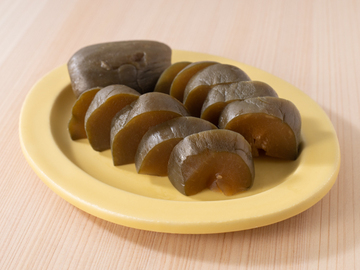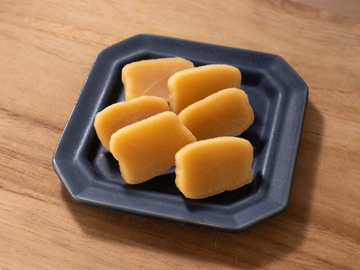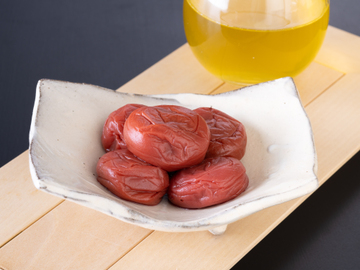Pickled

History and Culture
Japanese pickles have a long history, and it is believed that salted vegetable peels had already been made in the Jomon era. The record that refers to pickles for the first time is mokkan (narrow strips of wood on which an official message was written) in the Tenpyo era, which contains a description of "gourds pickled in salt." Subsequently, "Engishiki," an ancient book for codes and procedures on national rites and prayers written in the Heian era, also contains records of pickles that have been handed down until today, such as foodstuffs pickled in vinegar, hishio, and sake lees, and "suzubori," the original form of today's takuan (pickled daikon radish), suggesting that most pickles that have been handed down until today had already been produced in this era. Subsequently, in the Edo era, pickle manufacturers were born as the number of Japanese style restaurants and eating houses increased, and books that describe methods for pickling foodstuffs came to be published.
There are various local pickles in various regions of Japan, and it is said that the number of types of such local pickles exceeds 600. This is because there are a variety of marinades and pickling beds and foodstuffs that can be pickled, as well as different appropriate pickling methods for different marinades or pickling beds. These were combined to produce innumerable pickles.
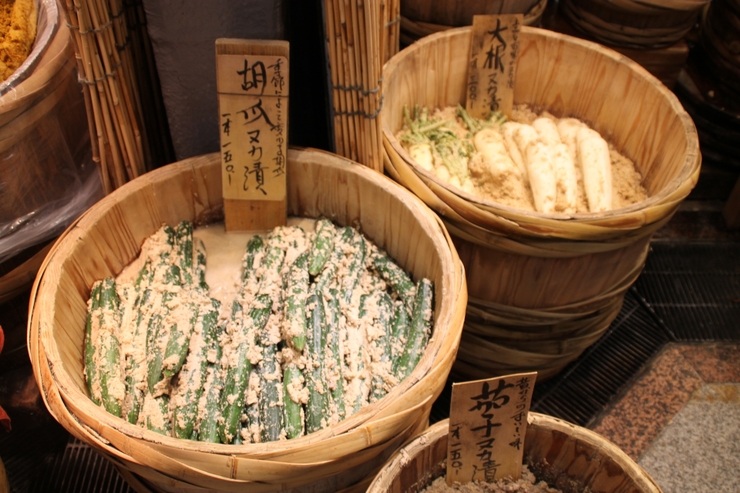
Characteristics and Types
There are two types of fermented pickles: one is pickles made by a process in which microorganisms are directly involved, and another is secondary fermented pickles made by using fermented products such as koji, miso, soy sauce, sake lees, and rice bran. There are also non-fermented pickles, which include umeboshi (pickled ume), red pickled ginger, and fukujin-zuke (sliced vegetables pickled in soy sauce). These may be called "asa-zuke" or "chomi-zuke," which are made by pickling foodstuffs in soy sauce, vinegar, or other seasoning liquids for a short period of time to soak the seasonings into the foodstuffs.
One of typical pickles is "nuka-zuke," which is foodstuffs pickled in rice bran. Rice bran is a by-product produced in the process of polishing brown rice, and contains rich amounts of nutrients. The method of picking foodstuffs in rice bran is based on the wisdom of pickling foodstuffs in rice bran paste made of rice bran to allow nutrients to adhere to them as well as to add new nutrients produced by fermentation to them. Fermentation also gives the original ingredients a flavor that they do not originally have. Takuan is a typical pickle made by picking daikon radish in rice bran paste, and there is a distinct difference in flavor between daikon radish before pickling and pickled daikon radish.
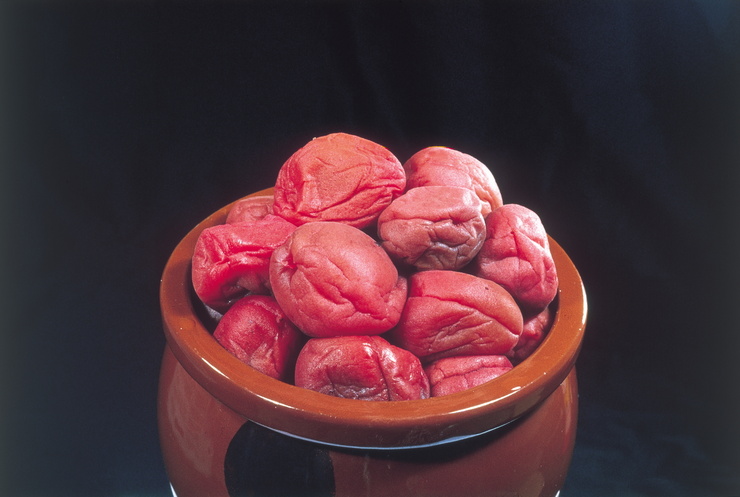
"Umeboshi" is one of typical Japanese pickles along with takuan. Umeboshi is salted and dried Japanese plum, and has such a long history that it had already been made more than 2,000 years ago in China. In Japan, as samurai society spread out in the Kamakura era, umeboshi was established among ordinary people.
While various pickles have been produced by fermentation, a technology for preserving foodstuffs, consumption of easy-to-eat pickles has been increasing due to advances in production technologies, changes in eating habits, and other reasons.
| Classification | Types |
|---|---|
| Vegetables pickled in salt | Vegetables may be pickled in salt to make products eaten as they are, or to preserve them longer. Salt-preserved foodstuffs are further pickled in soy sauce, vinegar, or other seasonings. ・Nozawana pickles, takana pickles, Hiroshimana pickles, umeboshi, chrysanthemum petal pickles, cherry blossom petal pickles, etc. |
| Vegetables pickled in soy sauce | Pickles made by desalting and pressing salt-preserved vegetables and soaking them in a soy sauce-based seasoning liquid to give them a flavor. ・Fukujin-zuke, teppo-zuke, inro-zuke, tamari-zuke, etc. |
| Vegetables pickled in miso | Pickles made by pickling salt-preserved vegetables in miso. ・Miso-zuke (kinkon-zuke), inro-zuke, etc. |
| Vegetables pickled in sake lees | Pickles made by pickling salt-preserved vegetables in sake lees. ・Nara-zuke, wasabi-zuke, sankai-zuke, moriguchi-zuke, etc. |
| Vegetables and fishery products pickled in koji | Pickles made by pickling vegetables or fishery products such as yellowtail or salmon in koji or a mixture of koji, sugars, mirin, and spices. ・Bettara-zuke, sagohachi-zuke, etc. |
| Vegetables pickled in vinegar | Vegetables pickled in vinegar. Fermentation does not occur because acetic acid has antibacterial properties and prevents microorganisms from propagating. ・Scallion pickles, ginger pickles, senmai-zuke, etc. |
| Vegetables pickled in rice bran | Vegetables pickled in race bran, a by-product of rice polishing. ・Takuan, iburigakko, hinona (a kind of turnip) pickles, kan-zuke, yamakawa-zuke, vegetables pickled in rice bran paste, etc. |
| Vegetables pickled in mustard | Vegetables pickled in Japanese mustard kneaded with rice koji or sake lees. ・Small eggplant pickles, cucumber pickled in mustard, etc. |
| Vegetables pickled in moromi | Vegetables pickled in moromi, from which soy sauce is made. Categorized as chomi-zuke (vegetables pickled in seasonings). ・Small eggplant pickled in moromi, cucumber pickled in moromi, teppo-zuke, etc. |
| Others | Pickles other than vegetables pickled in salt or seasonings. ・Suguki (a kind of turnip) pickles, siba-zuke, sunki (red turnip leaves) pickles, red turnip pickles, turnip pickles, etc. |
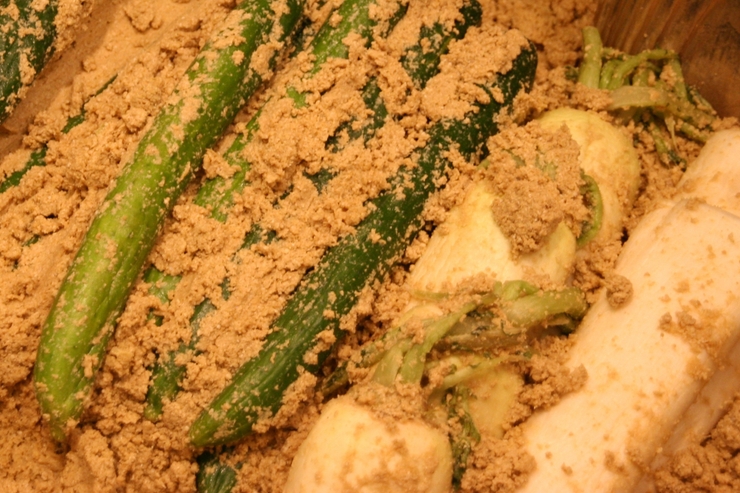
Production Method
A general method for producing pickles consists mainly of two processes. The first process is "salting," which is the basis of pickle making. Generally, vegetables are salt-preserved with a salt concentration of 15% or higher to prevent them from being spoiled by microorganisms and preserve them longer. Also, in the salting process, lactic acid bacteria adhering to vegetables grow, which adds to a flavor specific to fermentation. The second process is pickling vegetables salt-preserved in advance in soy sauce, vinegar, or other seasonings or in sake lees. Similarly to salt-preserving, drying is a technology for preserving foodstuffs. Daikon radish dried and then pickled in rice bran paste is takuan.
In the process of producing pickles, which is based on salt-preserving and drying, foodstuffs are further flavored by seasonings or fermentation to produce various kinds of pickles. Another major characteristic of Japanese pickles is that vegetables are pickled in various ways. For example, furu-zuke is pickles made by pickling vegetables for a long period of time, and asa-zuke is pickles made by pickling vegetables for a short period of time. Vegetables may also be pickled only once or thoroughly pickled several times.
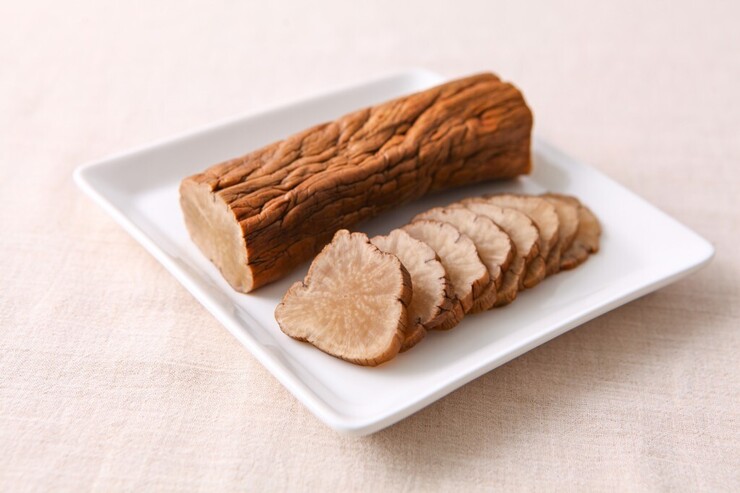
Relationship with Regions
Pickles are related largely to the climates of regions where they are produced. In cold regions such as Tohoku and Hokuriku, pickles have developed as a technology for preserving valuable foodstuffs in winter, and various kinds of pickles made by using local foodstuffs have been produced. In warm regions, on the other hand, pickles are often considered as easy-to-eat side dishes that allow people to better enjoy eating a staple food. Thus, pickles serve different roles depending on the region.
"Iburigakko" of Akita Prefecture, which means smoked pickles in Japanese, is made by drying daikon radish by hanging it in an indoor fireplace called "irori." This is because good weather does not last in winter in the region and it is difficult to dry it outdoors. This method makes daikon radish into unique pickles that have a smoke flavor and a flavor specific to nuka-zuke.
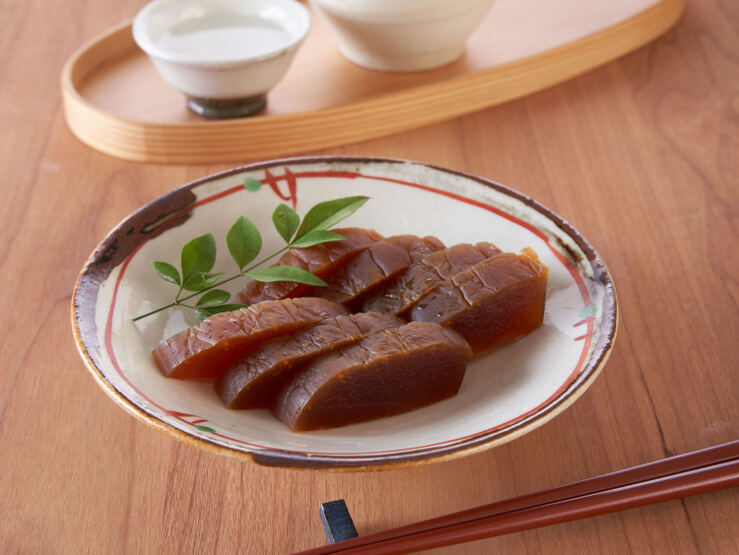
"Sunki pickles" are pickles handed down in Kiso, a town of Nagano Prefecture, and are known as pickles made without using salt. In the Kiso region, a cold highland located 800 m above sea level, salt was valuable. Then, pickles were made by fermenting leaves of red turnips, a local specialty of the region, with lactic acid bacteria contained in the stems and the base portions of the roots of the vegetable without using salt. Sunki pickles are pickles with a unique sour taste.
"Nara-zuke" is a traditional food of Nara Prefecture that has been handed down since the era of Heijo-kyo (capital of old Japan during the Nara era). Nara-zuke is vegetables picked in sake lees and is made by pickling various vegetables, such as melon cucumber, cucumber, small melon, daikon radish, or celery, in sake lees. By changing the sake lees in which vegetables are pickled several times in the production process, pickles with a rich flavor can be made.
"Yamakawa-zuke," pickles handed down in Kagoshima Prefecture, is made by spreading daikon radish fully dried in winter densely over a lattice placed in a jar together with a small amount of salt. A liquid exuding from daikon radish is accumulated on the bottom of the jar, and fermentation takes place due to air flowing into the jar. After a fermentation period of approx. 4 months, brown takuan is made. It is pickles produced using wisdom unique to the southern region.
Contribution to Sustainability and SDGs
Pickles contain rich amounts of dietary fiber and various nutrients produced by fermentation.
Increasing our chance of eating pickles is expected to contribute to healthy eating.
(3: Good health and well-being)
Reference
Yasuhiko Maeda, Shigeo Miyao, Hideaki Kuwahara, Yoshio Ota, Toshiro Hashimoto, Hisaharu Sugawara, Tomomi Akutsu, Kenichi Ishikawa, and Hiroki Matsuoka, edited by the Japanese Society of Traditional Food, "Nihon no Dento Shokuhin Jiten" [Encyclopedia of Traditional Japanese Food], Asakura Publishing Co., Ltd., p.83-152

